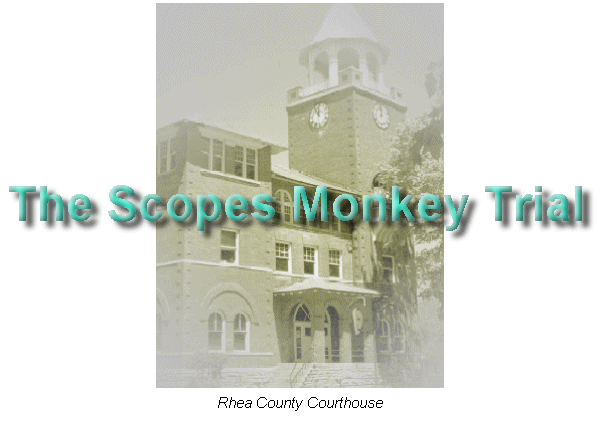The Decline in the Teaching of Evolution in Schools
MANY commentators, misguidedly following in the footsteps of F.L. Allen (Only Yesterday, 1931), have suggested that Darrow's grilling of Bryan was so effective that it made a laughing stock of the fundamentalist cause and put an end to the anti-evolution campaign across American. The reality is somewhat different.
Although the Press mostly chose to pillory Bryan, his own followers seemed to have regarded his performance as highly admirable. Indeed, far from losing momentum, even after Bryan's death the fundamentalist cause went from strength to strength. Just three days after Bryan died, an anti-evolution bill was put before the Georgia state legislature. In 1926 similar bills were presented to three more state assemblies. And in 1927 no less than eighteen different anti-evolution bills were submitted in fourteen states. Overall, two-thirds of all anti-evolutionist political activity in the 1920s occurred after the Scopes trial ended.
(For an analysis of the Darrow-Bryan confrontation - with extensive quotes - see Part 9: Bryan and Darrow.)
Most of the attempts to gain political support for the anti-evolutionist position eventually came to nothing, and beyond 1929 overtly political efforts in this direction dwindled down to a mere trickle. But this was certainly not, as many commentators still suggest, because the movement to remove evolution from the school curriculum ran out of steam, however.
On the contrary, the legal manouevres may well have come to an end because the battle to extinguish the teaching of evolution in schools was virtually (though only temporarily) won without the need for such draconian measures.
In 1926 the Superintendent of Education for the state of Louisiana demanded the removal of the six pages on evolution from Hunter's A Civic Biology (the textbook featured in the Scopes trial and the most popular biology textbook in use in high schools nationwide). Sure enough, when the book was released in a new edition in 1927 - as A New Civic Botany - the 'offending pages' had been substantially rewritten. The title "The Doctrine of Evolution" had been removed, along with the charts on pages 193 and 194 showing alleged evolutionary sequences. In fact even the word "evolution" had been changed to "development" wherever it occurred. The one remaining potential hot spot - the reference to Man's scientific definition as a member of the taxonomic class mammalia - was tempered by the assurance that "Man is the only creature that has moral and religious instincts".
By 1930, according to one pro-evolution commentator, Maynard Shipley, an estimated 70% of all public high schools omitted all reference to the theory of evolution in their science classes. This situation prevailed for over three decades after the Scopes Trial, so that as late as 1959 Harvard Professor of palaeontology George G. Simpson, in a lecture entitled "One Hundred Years Without Darwin are Enough", observed that "Most [US high school science textbooks] relegate evolution to a single section, preferably in the back of the book, which need not be assigned."
According to researchers Judith Grabiner and Peter Miller, "Not until 1960 was the treatment of evolution in the most widely used high school texts substantially improved over that found before the Scopes trial".
Another popular textbook - Truman Moon's self-published Biology for Beginners - clearly illustrates this trend. Having started out in 1921 with a picture of Darwin as the frontispiece, and an opening statement that the whole subject of biology was "based on the fundamental idea of evolution" and that "both man and ape are descended from a common ancestor", subsequent editions gave less and less attention to evolution. According to Grabiner and Miller, however, the less it featured evolutionist teaching, the more popular the textbook became until, by the 1950's - with all mention of the evolution of man, natural selection and even the word evolution removed - it "dominated the market".
The late Stephen Jay Gould, Harvard Professor of Geology, recalled (in his book Hen's Teeth and Horse's Toes (1981)) how, as late as 1956, "In a year of biology, ... the teacher granted Mr. Darwin and his entire legacy only an apologetic two days at the end of a trying year." As to his textbook on that course (Modern Biology, by Moon, Mann and Otto), Gould noted that it contained just one chapter on evolution - Chapter 58 (of 60) The hypothesis of racial development - which took up pages 618-636 out of a total of 662 pages.
We note, however, that this neither halted Mr Gould's interest in evolution, nor prevented him from becoming an internationally renowned evolutionist.
In the next two decades the teaching of evolution in schools began to move ahead, and at the same time a number of states which had adopted restrictive legislation began to repeal those laws (the Butler Act remained on the statute book, though it was never again invoked, until 1967). Yet even this was a less than wholehearted success for evolutionist teaching.
In 1986, Dr Michael Zimmerman investigated what was happening in high schools in the state of Ohio. (Zimmerman was Professor of biology at Oberlin College - the same college that Defense witness Maynard Metcalf graduated from, and subsequently taught at, many decades earlier). The results of the survey were a scientist's nightmare.
Some 37.6% of the respondents (all high school biology teachers) agreed that creationism should be part of the curriculum, and 25% thought that creationism should be part of the science course. Nor was this merely a theoretical reflection of the teachers' religious ideals. Taking account of both public and private schools it emerged that approximately 22% of all high school students in the state were already being taught creationism during science classes.
And that, from the evolutionist perspective, might be called the "good" news!

